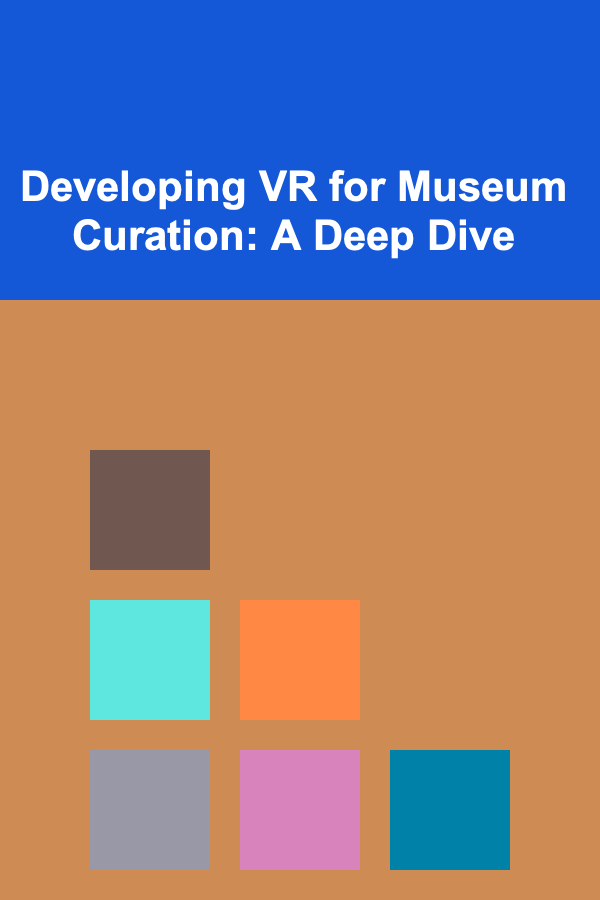
Developing VR for Museum Curation: A Deep Dive
ebook include PDF & Audio bundle (Micro Guide)
$12.99$7.99
Limited Time Offer! Order within the next:

Introduction: The Dawn of Immersive Curation
Virtual Reality (VR) is rapidly transforming numerous sectors, and the museum world is no exception. Beyond simple virtual tours, VR offers unparalleled opportunities for museum curation, redefining how audiences engage with artifacts, exhibitions, and historical narratives. This technology allows for the creation of immersive experiences that can transcend geographical limitations, overcome preservation challenges, and offer entirely new perspectives on cultural heritage. Developing VR for museum curation, however, demands a nuanced understanding of both the technological capabilities of VR and the fundamental principles of curatorial practice.
This article will delve into the complex process of developing VR experiences for museum curation. We will explore the key considerations, challenges, and best practices involved in leveraging VR to enhance storytelling, accessibility, and preservation within the museum context. From conceptualization and content creation to user testing and long-term sustainability, we will examine the critical steps necessary to create impactful and meaningful VR experiences that resonate with diverse audiences.
Understanding the Potential: VR's Unique Advantages in Curation
VR offers several distinct advantages that make it an ideal tool for museum curation:
- Immersive Storytelling: VR allows visitors to step into historical settings, interact with virtual artifacts, and experience narratives from a first-person perspective. This can create a deeper emotional connection with the subject matter and enhance understanding in a way that traditional displays cannot. Imagine experiencing ancient Rome firsthand or witnessing a key historical event as it unfolds.
- Enhanced Accessibility: VR can break down geographical barriers, allowing anyone with access to a VR headset to visit museums from anywhere in the world. This is particularly beneficial for individuals with disabilities, those living in remote areas, or those unable to travel due to financial constraints. Furthermore, VR can provide alternative sensory experiences for visually impaired visitors, such as tactile feedback or audio descriptions.
- Preservation and Conservation: VR provides a safe and non-invasive way to study and interact with fragile or sensitive artifacts. 3D models of artifacts can be created and manipulated within the virtual environment, allowing researchers and visitors to examine them in detail without risking damage. Furthermore, VR can reconstruct damaged or lost artifacts, offering a glimpse into the past that would otherwise be impossible.
- Interactive Learning: VR enables interactive learning experiences that engage multiple senses and encourage active participation. Visitors can solve puzzles, conduct virtual experiments, or collaborate with others in virtual spaces, fostering a deeper understanding of the subject matter. For example, a VR experience on ancient Egypt could allow users to virtually excavate a tomb and decipher hieroglyphs.
- Creative Reinterpretation: VR allows curators to experiment with new ways of presenting and interpreting artifacts. They can create dynamic visualizations, interactive narratives, and personalized experiences that cater to different learning styles and interests. This can lead to a more engaging and thought-provoking museum experience for all visitors. Imagine walking through a painting, experiencing the artist's perspective firsthand.
The Development Process: A Step-by-Step Guide
Developing a successful VR experience for museum curation requires a structured and collaborative approach. Here's a step-by-step guide to the process:
1. Conceptualization and Planning: Defining the Vision
The initial phase involves defining the goals, target audience, and scope of the VR experience. Key questions to consider include:
- What is the central message or narrative you want to convey? Clearly define the learning objectives and the key takeaways for the visitor. What historical period, artistic movement, or scientific concept will be explored?
- Who is your target audience? Consider the age, background, and interests of your intended audience. Tailor the experience to their specific needs and preferences. For example, a VR experience designed for children will differ significantly from one designed for academic researchers.
- What artifacts or collections will be featured? Identify the specific objects or artworks that will be showcased in the VR experience. Consider their significance, historical context, and visual appeal.
- What type of interaction will be incorporated? Determine the level of interactivity and engagement that you want to provide. Will users be able to explore freely, manipulate objects, or participate in guided tours?
- What platform and hardware will be used? Choose the VR platform (e.g., Oculus, HTC Vive, mobile VR) and hardware that are appropriate for your budget, technical capabilities, and target audience.
- What are the budgetary and time constraints? Develop a realistic budget and timeline for the project, taking into account the cost of content creation, software development, hardware, and personnel.
2. Content Creation: Building the Virtual World
The content creation phase involves developing the virtual environment, 3D models, audio elements, and interactive features. This typically involves a multidisciplinary team of:
- Curators: Provide historical accuracy, contextual information, and scholarly expertise. They are responsible for ensuring that the VR experience is aligned with the museum's mission and curatorial standards.
- 3D Modelers: Create accurate and detailed 3D models of artifacts, environments, and characters. Attention to detail is crucial for creating a realistic and immersive experience. Techniques like photogrammetry can be used to create highly realistic models from photographs.
- VR Developers: Program the interactive elements, user interface, and navigation system. They are responsible for ensuring that the VR experience is technically sound and user-friendly. Experience with game engines like Unity or Unreal Engine is essential.
- Sound Designers: Create immersive soundscapes and audio cues to enhance the sense of presence and realism. This includes ambient sounds, music, and voiceovers.
- Writers and Storytellers: Develop compelling narratives and scripts to guide the user through the VR experience. They are responsible for crafting engaging stories that are both informative and entertaining.
- User Interface (UI) Designers: Design intuitive and user-friendly interfaces for navigating the VR environment and interacting with objects. The UI should be seamless and unobtrusive, allowing the user to focus on the experience itself.
Key considerations during content creation:
- Accuracy and Authenticity: Ensure that all content is historically accurate and culturally sensitive. Consult with experts and use reliable sources to verify information.
- Optimization: Optimize the 3D models and textures to ensure smooth performance on the target hardware. VR experiences can be demanding on hardware, so optimization is crucial for preventing lag and ensuring a comfortable experience.
- User Experience (UX): Design the VR experience with the user in mind. Consider factors such as comfort, ease of navigation, and accessibility. Avoid elements that can cause motion sickness or discomfort.
- Storytelling: Craft a compelling narrative that engages the user and brings the artifacts to life. Use storytelling techniques to create a memorable and meaningful experience.
- Interactivity: Incorporate interactive elements that allow the user to explore, discover, and learn. Provide opportunities for active participation and engagement.
3. Development and Testing: Refining the Experience
The development phase involves building and refining the VR experience based on the content created. This is an iterative process that involves:
- Prototyping: Create early prototypes of the VR experience to test key features and interactions. This allows for early feedback and identification of potential problems.
- User Testing: Conduct user testing with target audience members to gather feedback on the VR experience. Observe how users interact with the VR environment and identify areas for improvement.
- Iteration: Iterate on the design and implementation based on user feedback. Make adjustments to the content, interaction, and user interface to improve the overall experience.
- Optimization: Continuously optimize the performance of the VR experience to ensure smooth and responsive gameplay. Monitor frame rates and identify areas where performance can be improved.
- Bug Fixing: Identify and fix any bugs or glitches that may be present in the VR experience. Thorough testing is essential for ensuring a polished and professional product.
4. Deployment and Evaluation: Sharing the Experience
The deployment phase involves making the VR experience available to the public. This can be done in a variety of ways:
- In-Museum Installation: Set up a VR station within the museum where visitors can experience the VR application. Ensure that the station is accessible and staffed by trained personnel who can provide assistance.
- Online Distribution: Make the VR application available for download on online platforms such as Steam or the Oculus Store. This allows users to experience the VR application from their own homes.
- Mobile VR: Develop a mobile VR version of the experience that can be accessed using smartphones and inexpensive VR headsets. This can significantly expand the reach of the VR experience.
- Educational Programs: Integrate the VR experience into educational programs and workshops. This can provide students with a unique and engaging learning experience.
Following deployment, it's crucial to evaluate the effectiveness of the VR experience. This can be done through:
- User Surveys: Collect feedback from users through surveys to assess their satisfaction with the VR experience. Ask questions about the content, interaction, and overall experience.
- Data Analytics: Track user behavior within the VR experience to identify areas where users are struggling or disengaged. This data can be used to improve the design and implementation of the VR experience.
- Learning Outcomes: Assess whether the VR experience has achieved its learning objectives. This can be done through pre- and post-tests or by observing user behavior within the VR environment.
- Impact Assessment: Evaluate the overall impact of the VR experience on the museum's mission and goals. Consider factors such as increased visitor engagement, improved learning outcomes, and enhanced accessibility.
Technical Considerations: Choosing the Right Tools and Technologies
Selecting the right tools and technologies is crucial for developing a successful VR experience. Here are some key technical considerations:
- VR Platforms: The choice of VR platform will depend on factors such as budget, target audience, and desired level of immersion. Popular platforms include:
- Oculus Rift/Quest: High-end VR headsets with excellent tracking and immersive capabilities. Require a powerful PC.
- HTC Vive/Vive Pro: Similar to Oculus Rift, with excellent tracking and immersive capabilities. Require a powerful PC.
- PlayStation VR: A more affordable option that works with the PlayStation console.
- Mobile VR (Google Cardboard, Samsung Gear VR, Google Daydream): Low-cost VR solutions that use smartphones as the display. Offer a less immersive experience but are highly accessible.
- Game Engines: Game engines provide the tools and frameworks necessary for creating interactive VR experiences. Popular options include:
- Unity: A versatile and widely used game engine with excellent support for VR development. Offers a wide range of assets and plugins.
- Unreal Engine: A powerful game engine known for its high-quality graphics and realistic rendering capabilities. Popular for creating visually stunning VR experiences.
- 3D Modeling Software: 3D modeling software is used to create the virtual environments and artifacts that are featured in the VR experience. Popular options include:
- Blender: A free and open-source 3D modeling software with a wide range of features.
- Autodesk Maya: An industry-standard 3D modeling software used for creating high-quality models and animations.
- Autodesk 3ds Max: Another industry-standard 3D modeling software with a strong focus on architectural visualization.
- ZBrush: A digital sculpting tool used for creating highly detailed and organic models.
- Audio Tools: Audio tools are used to create the soundscapes and audio cues that enhance the VR experience. Popular options include:
- Audacity: A free and open-source audio editing software.
- Adobe Audition: A professional audio editing software with a wide range of features.
- FMOD Studio: A powerful audio middleware engine used for creating dynamic and interactive audio experiences.
- Wwise: Another popular audio middleware engine used for creating immersive soundscapes.
- Programming Languages: Programming languages are used to implement the interactive elements and user interface of the VR experience. Popular options include:
- C#: The primary programming language used with Unity.
- C++: The primary programming language used with Unreal Engine.
Challenges and Considerations: Navigating the VR Landscape
Developing VR experiences for museum curation presents several challenges and considerations:
- Motion Sickness: VR can cause motion sickness in some users due to the disconnect between visual and vestibular cues. Careful design and optimization are crucial for minimizing motion sickness. Strategies include:
- Maintaining a stable horizon: Avoid sudden or jerky movements.
- Using teleportation for movement: Allow users to teleport between locations rather than walking or running.
- Providing a fixed point of reference: Display a small, static object in the user's field of view.
- Optimizing frame rates: Ensure that the VR experience runs at a consistent frame rate of at least 60 frames per second.
- Accessibility: VR experiences should be designed to be accessible to users with disabilities. Consider factors such as visual impairments, hearing impairments, and mobility limitations. Strategies include:
- Providing alternative sensory experiences: Use tactile feedback, audio descriptions, and haptic devices to provide alternative ways for users to interact with the VR environment.
- Offering customizable settings: Allow users to adjust the VR experience to their specific needs, such as changing the font size, color contrast, or movement speed.
- Providing closed captions and transcripts: Include closed captions for audio content and transcripts for spoken dialogue.
- Ensuring compatibility with assistive technologies: Test the VR experience with assistive technologies such as screen readers and voice recognition software.
- Cost: Developing VR experiences can be expensive, requiring significant investment in hardware, software, and personnel. Careful budgeting and resource allocation are essential. Consider:
- Prioritizing features: Focus on the most essential features and functionality to stay within budget.
- Leveraging existing assets: Use pre-made 3D models, textures, and audio assets to reduce development costs.
- Seeking funding opportunities: Explore grant opportunities and partnerships to secure funding for the VR project.
- Technological Obsolescence: VR technology is rapidly evolving, and hardware and software can become obsolete quickly. Plan for long-term maintenance and updates. Consider:
- Using open standards: Develop the VR experience using open standards to ensure compatibility with future hardware and software.
- Creating modular designs: Design the VR experience in a modular way to allow for easy updates and modifications.
- Planning for migration: Develop a plan for migrating the VR experience to new platforms and technologies as they become available.
- Cultural Sensitivity: When dealing with cultural heritage, it is crucial to approach the subject matter with sensitivity and respect. Consult with cultural experts and community stakeholders to ensure that the VR experience is culturally appropriate. Consider:
- Avoiding stereotypes: Be mindful of avoiding stereotypes and misrepresentations of cultures and communities.
- Seeking permission: Obtain permission from cultural groups before depicting their artifacts, traditions, or sacred sites.
- Providing context: Provide sufficient context and information to help users understand the cultural significance of the artifacts and narratives.
Future Trends: The Evolving Landscape of VR Curation
The future of VR curation is bright, with numerous exciting trends on the horizon:
- Haptic Technology: The integration of haptic technology will allow users to physically interact with virtual objects, enhancing the sense of presence and realism. Imagine feeling the texture of a Roman mosaic or the weight of a medieval sword.
- Artificial Intelligence (AI): AI can be used to personalize the VR experience, tailoring the content and interaction to the user's individual needs and preferences. AI-powered virtual guides can answer questions, provide personalized recommendations, and adapt the narrative based on user interactions.
- Augmented Reality (AR) Integration: Combining VR and AR technologies will allow for the creation of hybrid experiences that blend the virtual and real worlds. Visitors could use AR to overlay virtual information on real-world artifacts or create interactive displays that respond to their movements.
- Social VR: Social VR platforms will allow users to connect and interact with each other in virtual museums, creating collaborative learning experiences and fostering a sense of community. Visitors could take virtual tours together, discuss artifacts, or participate in collaborative projects.
- Cloud-Based VR: Cloud-based VR platforms will make it easier to access and distribute VR experiences, eliminating the need for powerful local hardware. This will significantly expand the reach of VR curation and make it accessible to a wider audience.
- Photorealistic Rendering: Advancements in rendering technology will enable the creation of photorealistic VR environments, blurring the lines between the virtual and real worlds. This will create even more immersive and engaging experiences for museum visitors.
Conclusion: A New Era for Museums
VR is revolutionizing museum curation, offering unprecedented opportunities for storytelling, accessibility, preservation, and learning. By embracing VR technology, museums can create transformative experiences that resonate with diverse audiences and bring cultural heritage to life in new and exciting ways. While challenges remain, the potential of VR to enhance the museum experience is undeniable. As technology continues to evolve, VR will undoubtedly play an increasingly important role in shaping the future of museums, making them more engaging, accessible, and relevant to a global audience. The key to success lies in a thoughtful and strategic approach, combining technical expertise with curatorial knowledge and a deep understanding of the audience's needs and expectations. By focusing on creating meaningful and impactful experiences, museums can leverage the power of VR to inspire, educate, and connect people with the world's cultural heritage.

Creating a Job Search Calendar: Stay Organized and Focused
Read More
How to Access Quality Free Educational Resources for Self-Improvement
Read More
How to Choose the Best Lighting Fixtures for Your Home Renovation
Read More
How to Light Your Home Like a Professional Interior Designer
Read More
How to Set Up a Home Party with Limited Space
Read More
How to Volunteer Ethically in a Foreign Community
Read MoreOther Products

Creating a Job Search Calendar: Stay Organized and Focused
Read More
How to Access Quality Free Educational Resources for Self-Improvement
Read More
How to Choose the Best Lighting Fixtures for Your Home Renovation
Read More
How to Light Your Home Like a Professional Interior Designer
Read More
How to Set Up a Home Party with Limited Space
Read More